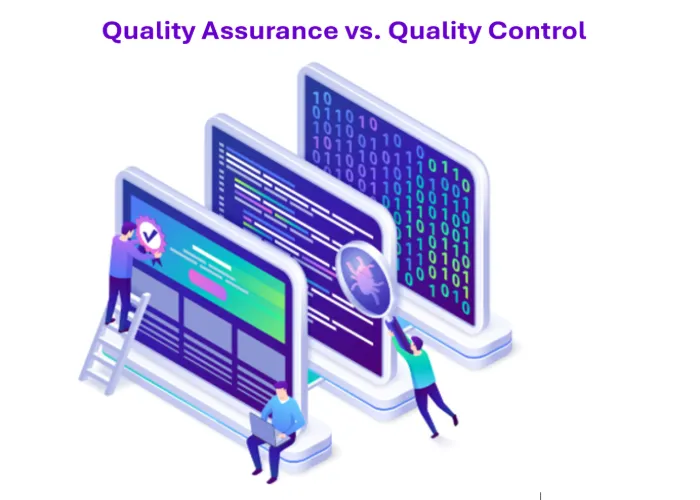Quality Control vs Quality Assurance Know the Difference

Introduction
Ensuring the quality of the final product is paramount in software development. Two essential processes that contribute to achieving this goal are Quality Assurance (QA) and Quality Control (QC). While these terms are often incorrectly used interchangeably, they represent distinct phases in the software development lifecycle (SDLC) with different objectives and methodologies.
In this article, I explore the key differences between Quality Assurance and Quality Control and how they complement each other to deliver high-quality software solutions.
Quality Assurance (QA): Ensuring Quality Throughout the Process
Quality Assurance (QA) is a proactive approach to preventing defects and ensuring that the software development process adheres to predefined quality standards. It focuses on improving the development process itself rather than identifying and fixing defects in the end product. The primary goal of QA is to establish processes, standards, and guidelines that facilitate the delivery of high-quality software solutions.
Here are some key features of Quality Assurance:
Process-Oriented:
QA is process-oriented, focusing on defining and implementing processes and procedures that govern the entire software development lifecycle. Establishing and refining processes, methodologies, and standards to optimize the software development lifecycle and enhance the efficiency and effectiveness of testing activities. This includes establishing acoding standards, defining testing methodologies, and creating documentation guidelines.
Preventive in Nature:
QA is preventive rather than corrective. It aims to identify and address potential issues before they manifest as defects in the final product. This involves conducting reviews, inspections, and audits to ensure compliance with quality standards and best practices.
Requirement Analysis:
Collaborating with stakeholders to elicit, document, and validate requirements, ensuring alignment with business objectives and user needs from the outset.
Quality Metrics and Measurement:
Defining and tracking key performance indicators (KPIs) and quality metrics to gauge the effectiveness of testing efforts, measure progress, and identify areas for improvement.
Risk Management:
Identifying potential risks and uncertainties associated with software development, assessing their impact and likelihood, and implementing mitigation strategies to minimize their impact on project success.
Continuous Improvement:
QA is an ongoing process of continuous improvement. It involves monitoring, measuring, and analyzing the effectiveness of existing processes and identifying areas for improvement. By collecting feedback and data throughout the development lifecycle, QA teams can make informed decisions to optimize processes and enhance product quality.
Focus on Prevention:
The primary focus of QA is on preventing defects from occurring in the first place. This includes implementing measures such as code reviews, static analysis, and automated testing to catch errors early in the development process and mitigate risks.
Training and Education:
Providing training, resources, and support to teams to enhance their skills, knowledge, and capabilities in software testing and quality assurance practices.
Quality Control (QC): Validating Quality of the Final Product
Quality Control (QC), on the other hand, is a reactive approach to ensuring the quality of the final product. It involves the systematic inspection, testing, and validation of the software to identify defects and deviations from quality standards. Unlike QA, which focuses on process improvement, QC is concerned with identifying and correcting defects in the final product before it is released to end-users.
At its core, software testing quality control has several key objectives:
Detecting Defects:
Identifying defects, errors, and inconsistencies in the software code, design, or functionality that do not meet specified requirements. The goal is to rectify these defects before they manifest in the production environment.
Validating Functionality:
Ensuring that the software behaves as intended, adhering to specified requirements, functionalities, and performance benchmarks.
Validating User Experience:
Assessing the usability, accessibility, and intuitiveness of the software from an end-user perspective, striving to deliver an optimal user experience.
Assuring Reliability:
Validating the stability, consistency, and resilience of the software under varying conditions and usage scenarios, minimizing the risk of failures or unexpected behavior.
Benefits of Quality Assurance & Quality Control
Enhanced Product Quality:
QA & QC ensure the delivery of high-quality software products that either meet or exceed user expectations. By integrating QA & QC practices throughout the software development lifecycle (SDLC), organizations can proactively identify and rectify potential defects, thereby minimizing the chances of releasing faulty or substandard software to end-users.
Improved Customer Satisfaction:
Quality software directly correlates to satisfied customers. By consistently providing reliable, functional, and user-friendly products, businesses can cultivate trust, nurture loyalty, and establish a distinctive edge in the competitive market environment.
Cost Savings:
While investing in comprehensive QA & QC practices may require initial expenditures, the long-term benefits significantly outweigh the costs. By detecting and addressing defects early in the development process, organizations can reduce expenses associated with post-deployment rework, maintenance, and support.
Risk Mitigation:
QA & QC serve as a proactive measure to identify and mitigate risks related to defects, security vulnerabilities, and compliance issues. By addressing potential risks at an early stage, organizations can safeguard their reputation, protect sensitive data, and ensure compliance with regulatory standards.
Accelerated Time-to-Market:
Effective QA & QC practices, including test automation and continuous integration, streamline the development process, enabling faster delivery of software solutions to the market. Rapid iteration and feedback cycles support agile development methodologies, enabling businesses to maintain a competitive edge.
Optimized Resource Utilization:
QA & QC optimizes resource allocation by identifying areas for improvement, streamlining workflows, and minimizing time and effort wastage. By prioritizing testing efforts and focusing on critical areas, organizations can maximize the return on investment in QA & QC activities.
Continuous Improvement:
QA & QC fosters a culture of continuous improvement within organizations. By actively seeking feedback, analyzing data, and refining processes, teams can enhance their QA & QC strategies, improve efficiency, and deliver increasingly superior software products over time.
Quality Assurance & Quality Control Complementary Roles in the Software Development Life Cycle:
While Quality Assurance and Quality Control have distinct objectives and methodologies, they are complementary processes that work together to ensure the delivery of high-quality software solutions. Quality Assurance focuses on preventing defects by establishing robust processes and standards, while Quality Control focuses on detecting and correcting defects in the final product through systematic testing and validation.
By implementing both QA and QC practices throughout the software development lifecycle, organizations can achieve greater confidence in the quality and reliability of their software products. QA ensures that processes are in place to prevent defects from occurring, while QC provides assurance that the final product meets quality standards and user expectations.
Conclusion
Quality Assurance and Quality Control are essential components of the software development process, each playing a unique role in ensuring the quality of software solutions. By understanding the key differences between QA and QC and leveraging their complementary strengths, organizations can deliver software products that meet the highest standards of quality and performance.




🗨️ Reader Comments